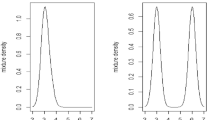Abstract
In the United States, the racial and ethnic statistics published by the National Center for Health Statistics (NCHS) assume that each member of the U.S. population has a race and ethnicity and that if a member is black or white with respect to his risk of one disease, he is the same race with respect to his risk of another. Such an assumption is mistaken. Race and ethnicity are taken by the NCHS to be an intrinsic property of members of a population, when they should be taken to depend on interest. The actual or underlying race or ethnicity of members of a population depends on the risk whose variation within the population we wish to describe or explain.
Similar content being viewed by others
Notes
The racial categories in the directive are white, black, American Indian or Alaskan Native, Asian, and Native Hawaiian or Other Pacific Islander, while the ethnic categories are Hispanic and non-Hispanic.
The U.S. is not the only country in which health statistics are tabulated by race or race is used to describe or explain variations in morbidity and mortality. In the U.K., for example, the population is stratified by the five racial categories listed by the ONS (Office for National Statistics), and the categories are used to describe or explain differences in the risk of death and disease within the U.K.
The CPS is a monthly survey conducted by the Bureau of Census of 60,000 U.S. households and the source of most national employment statistics.
Undercoverage is a possible source of measurement error in the numerator as well as denominator of death rates, but records of death are very complete in the U.S., while census counts or broad population surveys are not, and as result, measurement errors in the numerator are thought to be primarily due to misclassification and in the denominator to undercoverage (see Rosenberg, 7). However, had Rosenberg taken a member’s actual race to be her race on her death certificate, he would found a measurement error in the denominator due to a misclassification.
According to the published estimates, black males 25–34 years were undercounted in the 1990 census by 13% (Hogan 1993).
A response in the postenumeration survey is taken to be better indicator of a person’s race or ethnicity because (a) the record or coding of the response is taken to be more reliable or (b) the response is taken to be more thoughtful or considered and closer to the way the person really thinks of her race or ethnicity.
According to Waters, foreign-born are less likely than native born Americans to assign themselves the race others do, since native-born Americans are more accustomed to using the census race to classify people, while foreign-born Americans are more accustomed to using ethnicity or nationality to identify themselves.
Even in a admixed population, inter-racial differences in gene frequencies are more likely to be greater (or intra-racial differences smaller) if members are assigned their mother’s race than their self-reported race if the self-reported race of many members varies with time or context and mother’s race does not.
The definition was adopted by the U.S. Office of Economic Opportunity as a working definition of poverty when collecting economic statistics and by the U.S. Bureau of the Budget (now the OMB) in 1969 in the form of a directive (Policy Directive 14).
References
Edmonston B, Goldstein J, Tamayo J (eds) (1996) Spotlight on heterogeneity: the federal standards for racial and ethnic classification. National Academy Press, Washington
Friedman D, Cohen B, Averbach A, Norton J (2000) Race/ethnicity and OMB directive 15: implication for state public health practice. Am J Public Health 90:1714–1719
Fordham S, Ogbu J (1986) ‘Black students’ school success: coping with the burden of acting white. Urban Rev 18:176–206
Harris D, Sim JJ (2002) Who is multiracial? Assessing the complexity of lived race. Am Sociol Rev 67:614–627
Hogan H (1993) The 1990 post-enumeration survey: operations and results. J Am Stat Assoc 88(423):1047–1057
Kaufman JS, Cooper RS (2001) Commentary: considerations for use of racial/ethnic classification in etiological research. Am J Epidemiol 154:291–298
National Center for Health Statistics (1997) Healthy people 2000 review, U.S. Public Health Service
Office of Management and Budget (1997) Revisions to the standards for the classification of federal data on race and ethnicity. http://www.whitehouse.gov/omb/fedreg/1997standards.html
Peters KD, Kochanek KD, Murphy SL (1998) Deaths: final data for 1996, national vital statistics reports, vol 47 no 9. National Center for Health Statistics, Hyattsville
Risch N, Burchard E, Ziv E, Tang H (2002) Categorization of humans in biomedical research: genes, race and disease. Genome Biol 3:1–13
Root M (2005) The number of black widows in the national academy of science. Philos Sci 72(5):1197–1207
Root M (2007) Race in the social sciences. In: Turner SP, Risjord MW (eds) Handbook of the philosophy of science: philosophy of anthropology and sociology. Elsevier, Amsterdam
Rosenberg HM, Mauer JD, Sorlie PD, Johnson NJ (1999) Quality of death rates by race and hispanic origin: a summary of current research. Vital health statistics. National Center for Health Statistics, Hyattsville
Ruggles P (1990) Drawing the line: alternative poverty measures and their implications for public policy. The Urban Institute, Washington
Waters MC (2000) Immigration, intermarriage, and the challenges of measuring racial/ethnic identities. Am J Public Health 90:1735–1737
Author information
Authors and Affiliations
Corresponding author
Rights and permissions
About this article
Cite this article
Root, M. Measurement error in racial and ethnic statistics. Biol Philos 24, 375–385 (2009). https://doi.org/10.1007/s10539-008-9138-6
Received:
Accepted:
Published:
Issue Date:
DOI: https://doi.org/10.1007/s10539-008-9138-6



